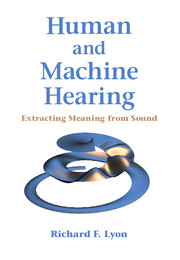Book contents
- Frontmatter
- Dedication
- Contents
- Foreword
- Preface
- Part I Sound Analysis and Representation Overview
- Part II Systems Theory for Hearing
- Part III The Auditory Periphery
- 13 Auditory Filter Models
- 14 Modeling the Cochlea
- 15 The CARFAC Digital Cochlear Model
- 16 The Cascade of Asymmetric Resonators
- 17 The Outer Hair Cell
- 18 The Inner Hair Cell
- 19 The AGC Loop Filter
- Part IV The Auditory Nervous System
- Part V Learning and Applications
- Bibliography
- Author Index
- Subject Index
- Plate section
16 - The Cascade of Asymmetric Resonators
from Part III - The Auditory Periphery
Published online by Cambridge University Press: 28 April 2017
- Frontmatter
- Dedication
- Contents
- Foreword
- Preface
- Part I Sound Analysis and Representation Overview
- Part II Systems Theory for Hearing
- Part III The Auditory Periphery
- 13 Auditory Filter Models
- 14 Modeling the Cochlea
- 15 The CARFAC Digital Cochlear Model
- 16 The Cascade of Asymmetric Resonators
- 17 The Outer Hair Cell
- 18 The Inner Hair Cell
- 19 The AGC Loop Filter
- Part IV The Auditory Nervous System
- Part V Learning and Applications
- Bibliography
- Author Index
- Subject Index
- Plate section
Summary
Up to the threshold of the nervous system, the general outline of the process of frequency analysis is fairly clear. There is little room for doubting that the first main step of the process is essentially a matter of filtering. True, when one encounters electrical filters with one input and a number of outputs they are likely to consist of parallel selective networks fed from a common source. However, cascaded networks with taps at their junctions are not unfamiliar, and they provide a fairly exact analogue, insofar as general lay-out is concerned, of the cochlear analyser. The input is at the basal end of the cochlear partition, and the taps are the receptors or nerve terminals disposed along the length of the partition.
—“Auditory frequency analysis,” J. C. R. Licklider (1956)The Linear Cochlear Model
The CARFAC model starts with a cascade of asymmetric resonators (CAR): linear two-pole– two-zero filters. We just need a recipe for how many sections to use, and how to set their coefficients to get a reasonable match to a linearized model of the human cochlea, at a range of levels.
The pole frequencies are chosen to correspond to equal spacing along the place dimension of the cochlea, by using the Greenwood map discussed in Chapter 14. The zeros are spaced a fraction of an octave above the pole frequencies.
Since we plan to extend this linear filter to incorporate nonlinearity through movement of the poles and zeros, we start with a filter form optimized to support that. A direct-form two-pole–two-zero filter stage with the input connected as shown in Figure 8.19 has a DC gain that does not vary as the coefficients are varied to move the poles. That implementation, referred to as PZFC in previous reports (Lyon et al., 2010b; Lyon, 2010), has been used in several applications of our cochlear modeling concept. But since the zeros don't move with the poles, it does not satisfy the physiologically observed condition that the impulse response zero crossings are very nearly unchanged with variation in level (Carney et al., 1999). For that, we need to move the zeros, too. The coupled form in Figure 16.1 makes it easy to move the zeros the same amount as the poles, which gives nearly the condition that we want.
- Type
- Chapter
- Information
- Human and Machine HearingExtracting Meaning from Sound, pp. 299 - 308Publisher: Cambridge University PressPrint publication year: 2017



